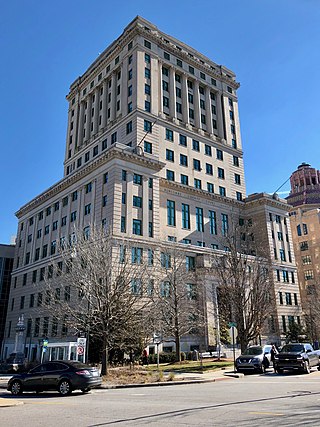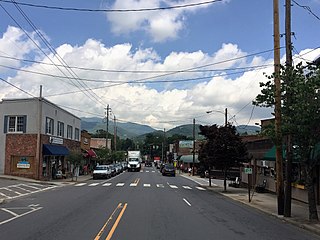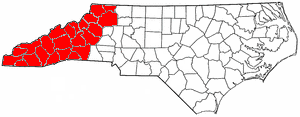Related Research Articles

Buncombe County is a county located in the U.S. state of North Carolina. It is classified within Western North Carolina. The 2020 census reported the population was 269,452, making it the 7th-most populous county in North Carolina. Its county seat is Asheville. Buncombe County is part of the Asheville, NC Metropolitan Statistical Area.

Roswell is a city in northern Fulton County, Georgia, United States. At the official 2020 census, the city had a population of 92,883, making Roswell the state's ninth largest city. A suburb of Atlanta, Roswell has an affluent historic district.

Asheville is a city in and the county seat of Buncombe County, North Carolina, United States. Located at the confluence of the French Broad and Swannanoa rivers, it is the most populous city in Western North Carolina, and the state's 11th-most-populous city. According to the 2020 census, the city's population was 94,589, up from 83,393 in the 2010 census. It is the principal city in the three-county Asheville metropolitan area, which had an estimated population of 417,202 in 2023.

Black Mountain is a town in Buncombe County, North Carolina, United States. The population was 8,426 at the 2020 United States census. It is part of the Asheville Metropolitan Statistical Area. The town is named for the old train stop at the Black Mountain Depot and is located at the southern end of the Black Mountain range of the Blue Ridge Mountains in the Southern Appalachians.

Swannanoa is a census-designated place (CDP) in Buncombe County, North Carolina, United States. The population 5,021 at the 2020 census up from 4,576 at the 2010 census. The community is named for the Swannanoa River, which flows through the settlement. It is part of the Asheville Metropolitan Statistical Area.

The National Society Daughters of the American Revolution is a lineage-based membership service organization for women who are directly descended from a patriot of the American Revolutionary War. A non-profit group, the organization promotes education and patriotism. Its membership is limited to direct lineal descendants of soldiers or others of the American Revolution era who aided the revolution and its subsequent war. Applicants must be at least 18 years of age and have a birth certificate indicating that their gender is female. DAR has over 190,000 current members in the United States and other countries. The organization's motto is "God, Home, and Country".

Biltmore Estate is a historic house museum and tourist attraction in Asheville, North Carolina. Biltmore House, the main residence, is a Châteauesque-style mansion built for George Washington Vanderbilt II between 1889 and 1895 and is the largest privately owned house in the United States, at 178,926 sq ft (16,622.8 m2) of floor space and 135,280 sq ft (12,568 m2) of living area. Still owned by George Vanderbilt's descendants, it remains one of the most prominent examples of Gilded Age mansions.

The Swannanoa River flows through the Swannanoa Valley of the region of Western North Carolina, and is a major tributary to the French Broad River. Its headwaters arise in Black Mountain, North Carolina; however, it also has a major tributary near its headwaters: Flat Creek, which begins on the slopes of Mount Mitchell. The Swannanoa River ends at its confluence with the French Broad, now within the grounds of the 8,000-acre Biltmore Estate in Asheville.

Pisgah National Forest is a National Forest in the Appalachian Mountains of western North Carolina. It is administered by the United States Forest Service, part of the United States Department of Agriculture. The Pisgah National Forest is completely contained within the state of North Carolina. The forest is managed together with the other three North Carolina National Forests from common headquarters in Asheville, North Carolina. There are local ranger district offices located in Pisgah Forest, Mars Hill, and Nebo.

The Black Mountains are a mountain range in western North Carolina, in the southeastern United States. They are part of the Blue Ridge Province of the Southern Appalachian Mountains. The Black Mountains are the highest mountains in the Eastern United States. The range takes its name from the dark appearance of the red spruce and Fraser fir trees that form a spruce-fir forest on the upper slopes which contrasts with the brown or lighter green appearance of the deciduous trees at lower elevations. The Eastern Continental Divide, which runs along the eastern Blue Ridge crest, intersects the southern tip of the Black Mountain range.

Chauncey Delos Beadle was a Canadian-born botanist and horticulturist active in the southern United States. He was educated in horticulture at Ontario Agricultural College (1884) and Cornell University (1889). In 1890 the landscape architect Frederick Law Olmsted hired him to oversee the nursery at Biltmore Estate in Asheville, North Carolina on a temporary basis. Olmsted had been impressed by Beadle's "encyclopedic" knowledge of plants. Beadle ended up working at Biltmore for more than 60 years, until his death in 1950. He is best known for his horticultural work with azaleas, and described several species and varieties of plants from the southern Appalachian region. He and three friends, including his "driver and companion" Sylvester Owens, styled themselves the Azalea Hunters. The group traveled over the eastern United States for a period of fifteen years, studying and collecting native plants. In 1940 Beadle donated his entire collection of 3,000 plants to Biltmore Estates.

Western North Carolina is the region of North Carolina which includes the Appalachian Mountains; it is often known geographically as the state's Mountain Region. It contains the highest mountains in the Eastern United States, with 125 peaks rising to over 5,000 feet in elevation. Mount Mitchell at 6,684 feet, is the highest peak of the Appalachian Mountains and mainland eastern North America. The population of the 23 most commonly associated counties for the region, as measured by the 2020 U.S. Census, is 1,149,405. The region accounts for approximately 11% of North Carolina's total population.

The Asheville metropolitan area is a metropolitan area centered on the principal city of Asheville, North Carolina. The U.S. Office of Management and Budget defines the Asheville, NC Metropolitan Statistical Area, a metropolitan statistical area used by the United States Census Bureau and other entities, as comprising the four counties of Buncombe, Haywood, Henderson, and Madison. The area's population was 424,858 according to the 2010 census, and 469,454 according to the 2020 census.

The Carson House is a historic house and museum located in Marion, North Carolina. It was the home of Col. John Hazzard Carson, and served as the McDowell County courthouse when the county was first organized in 1842.

The Cathedral of All Souls, also referred to as All Souls Cathedral, is an Episcopal cathedral located in Asheville, North Carolina, United States of America. All Souls was built by George Washington Vanderbilt II, the grandson of railroad baron, Cornelius Vanderbilt, in 1896, to serve as the local parish church for Biltmore Village, which had been developed near his Biltmore Estate, and designated as a cathedral in 1995. The Right Reverend José Antonio McLoughlin is the current bishop seated at the cathedral.
Richard Sharp Smith was an English-born American architect, noted for his association with George W. Vanderbilt's Biltmore Estate and Asheville, North Carolina. Smith worked for some of America's important architectural firms of the late 19th century—Richard Morris Hunt, Bradford Lee Gilbert, and Reid & Reid—before establishing his practice in Asheville. His most significant body of work is in Asheville and Western North Carolina, including dozens of buildings that are listed on the National Register of Historic Places or are contributing structures to National Register Historic Districts.
Davidson's Fort was a Revolutionary War frontier fort and precursor of town of Old Fort, North Carolina. It was built in 1776 to protect the white settlers from the Cherokee. Davidson's Fort was one of dozens of similar outposts constructed along the frontiers in Georgia, North Carolina, South Carolina, and Virginia to protect settlers from Native Americans who had sided with the British in the war. It was also known as Catawba Fort, Fort Royal, Old Fort, Rutherford's Fort, and Upper Fort.
Bailey Law School was a private law school located in Black Mountain and Asheville, North Carolina. It was established in 1859 by judge John Lancaster Bailey in Black Mountain but moved to Asheville after the Civil War. It operated in Asheville for ten years before closing.
North Fork Reservoir is a freshwater reservoir in Black Mountain, North Carolina, near Swannanoa. It was created by damming the north fork of the Swannanoa River to provide a source of water for Asheville, North Carolina. The city of Asheville purchased 5,000 acres of land in the North Fork Valley through eminent domain and flooded it to create the reservoir.
John Hazzard Carson was an American military officer, politician, planter, and revolutionary. He served in the North Carolina Militia during the American Revolutionary War and as a delegate for Burke County to the Fayetteville Convention. Carson served in the North Carolina House of Representatives in 1805 and 1806. He was the owner of Carson House, a plantation in Marion, North Carolina.
References
- 1 2 3 4 5 6 7 Monk, Karrigan (June 3, 2024). "Black Mountain native Regina Lynch-Hudson 1st Carson descendent of color inducted to DAR". Black Mountain News . Retrieved October 10, 2024.
- ↑ Clark, Paul. "The Cragmont house that came from far away". Black Mountain News.
- 1 2 3 "Regina Lynch-Hudson HGTV". Asheville Citizen-Times. August 24, 2006. p. 105 – via newspapers.com.
- ↑ Tribune, Atlanta (June 25, 2015). "Blissbehavin' at the Biltmore Estate". Atlanta Tribune.
- ↑ Spencer, Bridget (July 4, 2024). "Roswell woman of color finds ancestral roots in Revolutionary War". www.atlantanewsfirst.com.
- 1 2 "Lynch-Hudson Makes History, Joins Daughters of the American Revolution". Hudson Valley Press. August 7, 2024.
- 1 2 3 "Black Mountain native follows lineage to historic Carson House". The Valley Echo. June 6, 2024.
- 1 2 "FamilyTreeDNA - Genetic Testing for Ancestry, Family History & Genealogy". www.familytreedna.com.
- ↑ "A Masterful Collaboration" (PDF). www.thewritepublicist.com.
- ↑ LLC, Stage 32. "Regina Lynch-Hudson - Regina's Bio, Credits, Awards, and more". Stage 32.
{{cite web}}: CS1 maint: numeric names: authors list (link)